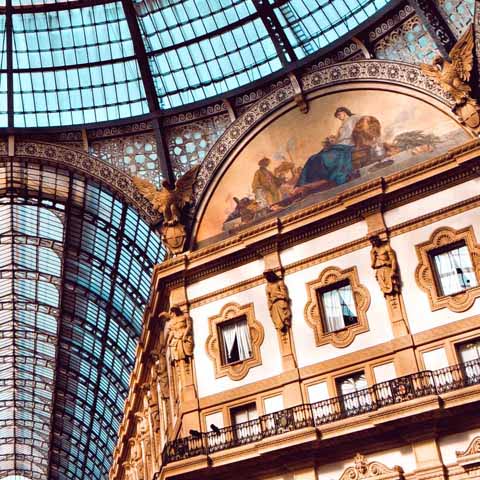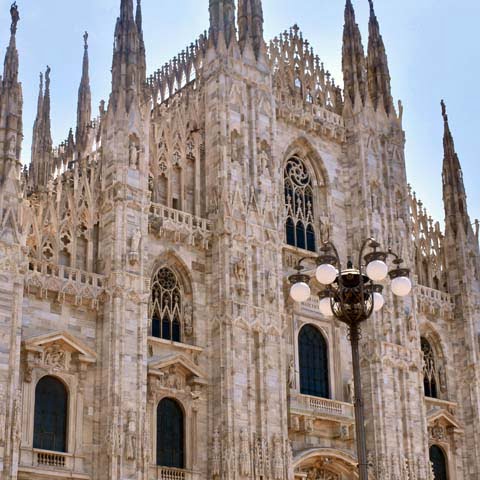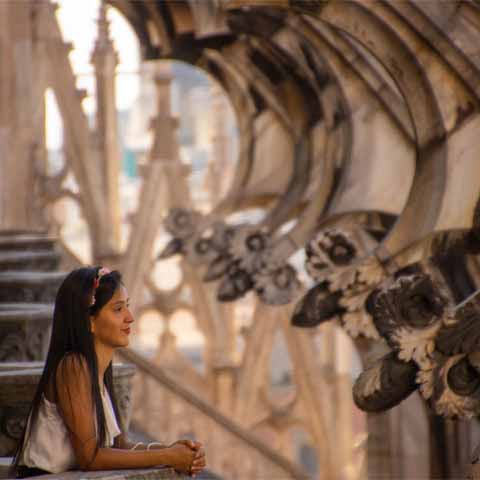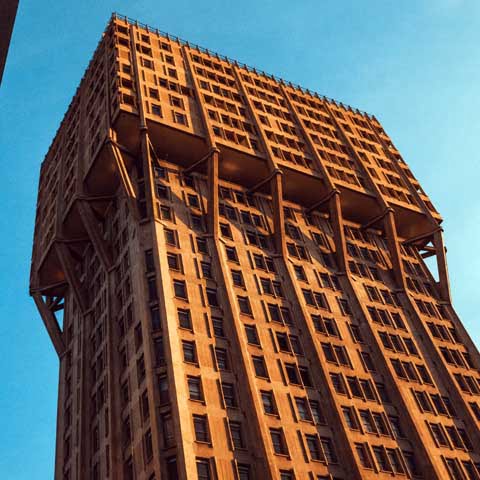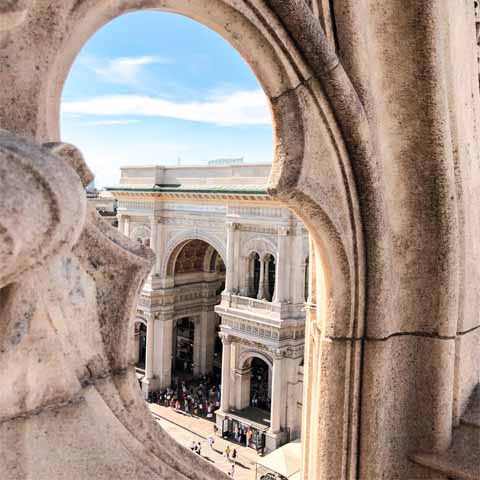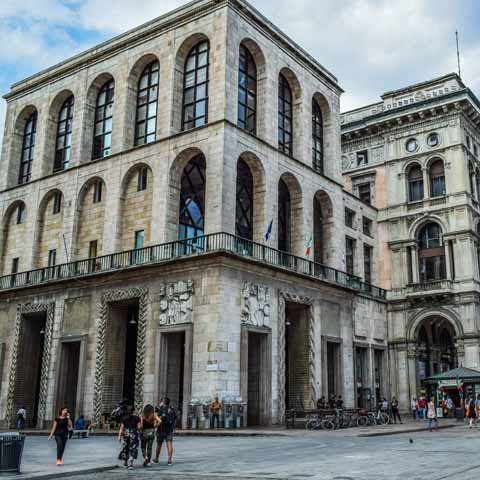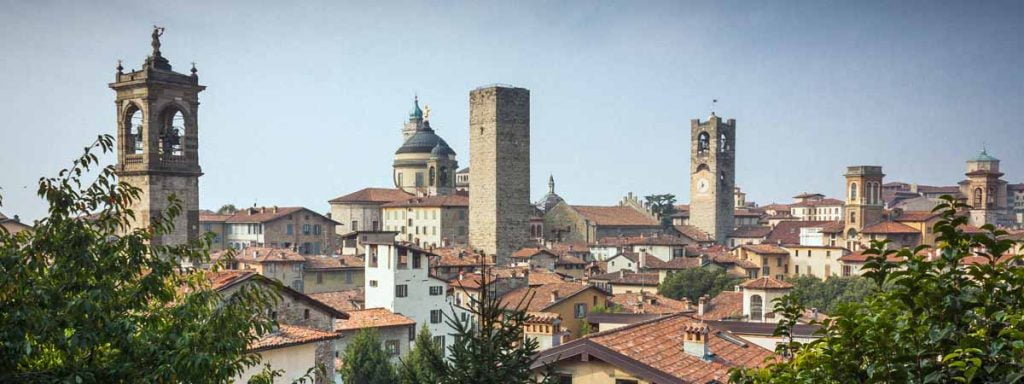Among Italy’s most prized cultural treasures and a staple in the fashion industry, Milan is an amazing city located in the central sector of the Po Valley, between the pre-alpine relief and the Ticino and Adda rivers.
Situated at the convergence of some of the most important trade routes between Italy and the rest of Europe, Milan boasts impressive infrastructure that connects it with the main European capitals as well as with other important Italian centers, such as Turin, Genoa, Venice, and Bologna.
The second largest Italian city by population, Milan is also one of the main engines of the Italian economy. The city has an important industrial, commercial, and financial role, and spans over a vast metropolitan area, which is the largest in Italy by population.
An episcopal seat and important university center, the city was in the spotlight in 2015 when it hosted the Universal Exposition themed Feeding the Planet, Energy for Life (also known as Expo 2015 or the 2015 Expo). The 2015 Expo achieved great success and gave Milan new opportunities to surpass potential economic crises.
Packed with monuments and places of interest, Milan also boasts a rich and intricate history.
PREHISTORY OF MILAN
Despite its historical importance in the evolution of Italy, Milan’s founding is rather recent, dating back to the sixth century B.C. It is believed that the first tribe to settle in the region was the Gallic tribe of the Insubri, who defeated the Etruscans, and the city was founded in roughly 590 B.C. by the Insubri Celts.
After acting as a true bulwark against the Ligurians, Milan was temporarily occupied by the Romans fighting against Gaul, in an attempt to prevent their invasion to the north of the Po River. After fierce battles between Rome and the Celtic populations in the region, the Romans finally took control over the city.
The Roman conquest proved to be influential and the settlement was named Mediolanum (meaning “in the middle of the plain” in Latin).
In fact, due to its fortunate position at the center of a fertile plain, Milan became the intersection of many important roads converging from Liguria, Veneto, Piedmont, and the Alps.
Growing in its importance, the city gained Latin recognition in 89 BC, and the citizens were awarded Roman citizenship about forty years later.
Further development during the Roman era transformed Milan into a place of flourishing trade and artisanal production.
HISTORY OF MILAN
The fall of the Roman Empire did not greatly affect Milan since the city acquired strategic importance as a center for organizing war campaigns against Germanic invasions. Frequently supported by the imperial court, during the fourth century AD, the city became the seat of the prefect of the praetorium and of the vicar of Rome.
In 313, Emperor Constantine issued the edict of tolerance, known as the Edict of Milan, and soon after, the Diocese of Milan emerged, which received great support from Bishop Ambrogio (St. Ambrose). Together with the bishop, Milan engaged in battles against Arian theology, becoming an active presence in the political events of the time.
However, the beginning of the fifth century brought bad news for Milan; the city lost its role of capital of the Western Roman Empire, which passed to Ravenna, where Emperor Honorius transferred his court in an attempt to escape the Visigoths.
The city used its military forces to fight off the Goths, however, alone and weakened, Milan stood no chance against Attila’s Huns, who managed to work their way into the city, setting it on fire in 452.
Abandoned and destroyed, Milan found its help in Bishop Eusebius who, without any support from civic authority, decided to commence the city’s restoration works starting with the main church, dedicated to Santa Tecla.
However, the bishop’s efforts were brought to ruin once again in the sixth century, during the Gothic-Byzantine war.
At the end of the Gothic domination, the imperial restoration imposed by Justinian failed to revive the city which, almost defenseless, was occupied by the Lombards in 569.
With its annexation to the Lombard Kingdom in 643, Milan became the seat of a Lombard Duke, although it enjoyed little importance under the new administration. Nevertheless, thanks to its Catholic faith, it slowly started to regain its importance during the progressive process of conversion of the Lombards from Arianism to Catholicism.
This led to a change of fate for the city, and during the eighth century, Milan gradually acquired a prominent urban, economic, and military position in the kingdom.
What resulted was a relative harmony between the Germanic and Latin populations under the moderating and directive action of the episcopate, which acted more like a real government within a state than as a municipal administrative power.
The assumption of power by Charlemagne in 774 did not bring much change. The bishops assumed a prominent role that played an active and sometimes decisive part in the dynastic conflicts of the following centuries.
With the arrival of the Carolingians, the clergy tended to constitute an ecclesiastical feudality capable of integrating and balancing the secular role of the church, achieving the religious and political unity of the Sacred Empire.
However, in the second half of the eleventh century, the evolution of the episcopal lordship was diverted by the emergence of new circumstances. The politically matured and economically advanced secular forces gave rise to a general expansion of production and trade, which eventually led to the establishment of a local aristocracy formed by noble families, merchants, and entrepreneurs.
The new classes began to express their aspiration to become governors of the city, undermining the episcopal regime.
On the background of struggles between the reform of the Church and the popular movements, the episcopal government entered into a period of crisis which favored the establishment of a lay administration governed by consuls elected by an assembly of citizens.
The new city-state, while trying to give itself a constitutional structure capable of balancing the needs of a rapidly changing society and under the pressure of the ever-growing economic interests of the bourgeois, adopted an aggressive expansion policy. Milan’s aim was to assimilate the neighboring countryside and to undermine the jurisdiction of the nearby towns of Pavia, Como, and Lodi.
Trying to stop the expansionist ambitions of the city, the neighboring territories gave full support to Frederick Barbarossa who engaged in an offensive attack against the municipality. Yet Milan, although dilapidated and divided, managed to recover its forces thanks to the solidarity of the Lombard League and the support of Pope Alexander III and his bishops.
The cleric helped transform Milan from an enemy into an ally, with the city becoming the soul of the war for the autonomy of the municipalities. Playing a decisive role in the victorious battle of Legnano and determining the subsequent Peace of Constance, Milan gained an important role and the admiration of the other cities in the League.
However, this did not mean that life in Milan became less agitated. Almost uninterrupted internal struggles for power between the various factions continued to undermine economic development.
In the end, the collegiate government of the consuls was replaced by a sole and foreign Podestà. Complex statutory legislation replaced the old codes. Milan received more magistrates, offices, and councils destined to improve administration and maintain the unstable political balance of the nobles.
On the background of this state of crisis, Milan faced the offensive of Frederick II and was defeated in Cortenuova in 1237.
The second part of the thirteenth century found Milan in the middle of battles between the Guelphs and the Ghibellines. The latter, fighting under the protection of Bishop Ottone Visconti, gained control over the city and established a lordship which allowed the nobility to participate in the reformation of the municipality’s constitution.
Undoubtedly, it was the Visconti who laid the foundation of the new Milanese territory that comprised almost all of Lombardy’s territory, including Novara, Alessandria, Asti, Genoa and Bologna, among other cities.
In the unstable system of the Italian states, Milan acquired a pre-eminent role, opposing its rivals and often defeating the coalitionist ambitions of the main principalities including Florence, Venice, Piedmont, and even the Papal State, becoming the antagonistic pole of the Kingdom of Naples.
Under Galeazzo Visconti, the Milanese expansion towards Emilia-Romagna clashed against the Guelph league. Supported by the Papacy of Avignon, the state reached its maximum expansion and power, successfully extending its control in Veneto, Padua, Emilia, and Bologna.
Gian Galeazzo Visconti acquired the title of Duke of Milan and started complex architectural works that included the famous Cathedral of Milan.
The crisis that followed the demise of Gian Galeazzo Visconti at the beginning of the fifteenth century resulted in the murder of his successor, Giovanni Maria Galeazzo, in 1412. At the same time, taking advantage of the situation, Venice started to advance and gain more and more territories in eastern Lombardy.
The crisis was overcome by Gian Galeazzo’s second son, Filippo Maria Visconti, who ruled over Milan from 1412 to 1447. With a very effective financial policy and a strong military effort, he succeeded in reconstituting the duchy and restoring its power.
At his death, due to no direct heirs, a group of aristocrats and intellectuals gave life to the fragile Ambrosian Republic, evoking a restoration of the municipal liberties. At the same time, the other cities of the duchy claimed their independence, while the actual succession was disputed between the Visconti, Savoy, and Sforza.
After long struggles, Francesco Sforza proclaimed himself Duke of Milan, acclaimed by the masses. In 1454, he signed the Peace of Lodi with Venice, and under the Sforza dynasty, Milan and the entire duchy enjoyed a long period of peace in which the capital gained international importance.
The fate of Milan was bound to change once again at the beginning of the sixteenth century when Ludovico Maria Sforza, also known as Ludovico il Moro, came to power. Driven by an ambitious and tortuous policy, Moro favored foreign intervention in the duchy’s affairs, giving Louis XII of France the perfect occasion to occupy the city.
The first half of the century saw Milan struggling between periods of French domination and Swiss protection, until the power fell into the hands of Philip I, an event that marked the beginning of the Spanish domination.
The duchy passed under the Spanish Habsburgs, who entrusted the administration to a governor nominated by a director endowed with broad civil and military powers. The governor, flanked by a Senate reminiscent of the Sforza era and by a Chamber of Commerce reminiscent of the Visconti constitution had extensive administrative powers, including the collection of revenue and decision-making on quarrels.
The governor also established a secret council and a congregation of the state. The Spaniard domination did not alter the administrative structure of the duchy, but it considerably worsened its conditions.
Under these events, although the Lombard economy remained the most advanced and active of the peninsula, the agricultural and industrial sectors entered a period of stagnation, despite the efforts of the local administrators.
Trade was also hampered by the new financial regulations and by the excessive favors granted to nobility.
If this was not enough, Milan and the entire duchy also had to struggle with two plague epidemics at the end of the sixteenth and middle of the seventeenth centuries. Famines and war finally contributed to decimating the population.
The beginning of the eighteenth century brought new challenges, as Milan fell under Austrian occupation. With the Peace of Aachen, though, the city entered a period of peaceful development of the industry, arts, and civic life.
Administration and justice were reformed under the rule of Maria Theresa and her successors, who abolished torture and the death penalty towards the end of the century. The ecclesiastic tribunals and the Inquisition were also suppressed, while the new rulers favored the construction of new industries. Milan transformed and started to expand its influence once more.
In the middle of these events, the Enlightenment and revolutionary ideas originating from France started to penetrate the minds of the locals. When Napoleon entered the city after the victory of Lodi, he was received with true enthusiasm in the hope of new and wider liberties.
Under the French rule, Milan became the capital of the Cisalpine Republic, before falling to the Austrian Empire once more. In March 1848, Milan rebelled against the Austrians during the famed Cinque Giornate (“Five Days”) that pushed Radetzky out of the city.
Milan was briefly under the dominion of the Kingdom of Piedmont-Sardinia before Austria recaptured the city. With the ideals of the Risorgimento (the movement for Italian unification) flowering in the fractured Italian states, Risorgimento leaders (including Cavour, Garibaldi, and Mazzini), pressured the Kingdom of Piedmont-Sardinia to form an alliance with France. As a result, French and Savoy troops drove the Austrians out of Northern Italy, paving the way for Italian unification in 1861.
Once entered into the Kingdom of Italy after its unification, the city stood out thanks to its economic initiatives and its cultural and informational activities, including the founding of the newspaper Corriere della Sera in 1876.
In the last two decades of the nineteenth century and the early twentieth century, Milan became the most industrialized city in Italy and one of the most active municipalities in the country’s political scene.
Today, Milan still preserves its industrial grandeur, entrepreneurial and innovative spirit, and the determination that characterized it along its entire history. Additionally, in recent years Milan has capitalized on its rich cultural and artistic heritage to become one of Italy’s top travel destinations.
ARCHAEOLOGY IN MILAN
The archaeological remains of Milan date back essentially to the Roman city; in fact, in many places scattered throughout the metropolitan area, the square perimeter and checkerboard plan characteristic of the Augustan age can still be seen.
In the heart of the city, visitors can still observe the remains of the Roman forum, a large thermal building, and part of the baths.
Under the current road of Porta Romana lie the remains of the Roman amphitheater and an octagonal mausoleum, as well as the Corinthian columns of the portico of San Lorenzo, which belonged to a Roman monument from the Imperial age.
Besides these open-air sites, the Archaeological Museum of Milan is also noteworthy. Housing important collections, the museum exhibits many artifacts found during excavations in Milan and the entire Lombardy region.
Among the museums arranged in the Sforza Castle, there are interesting collections of medieval art and historic artifacts that deserve a visit.
Don't just see Italy, live it.
Your dream trip to Italy has never been closer
No more endlessly scrolling travel sites. Our travel experts will craft the perfect, one-of-a-kind trip just for you.

300+
DESTINATIONS
We offer more Italian destinations than any travel site. Do and see more with Trips 2 Italy.
1 (of a kind)
ITINERARIES
Because your dream trip to Italy should be designed for you, not for the masses.
100%
PEACE OF MIND
From flights and accommodations, to food and activities - we take care of every detail.
